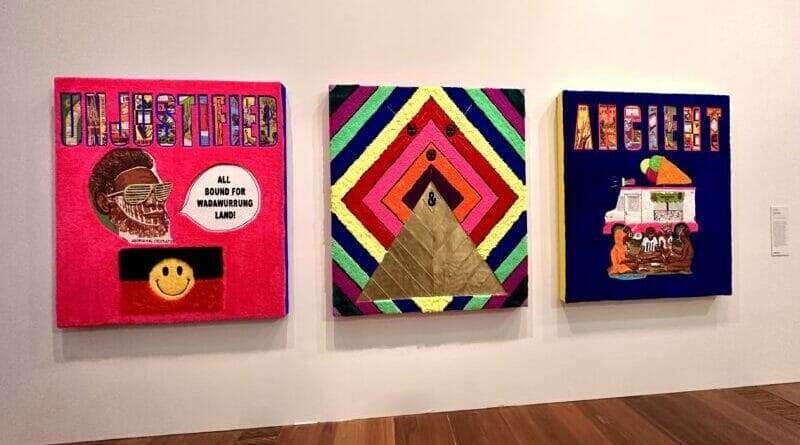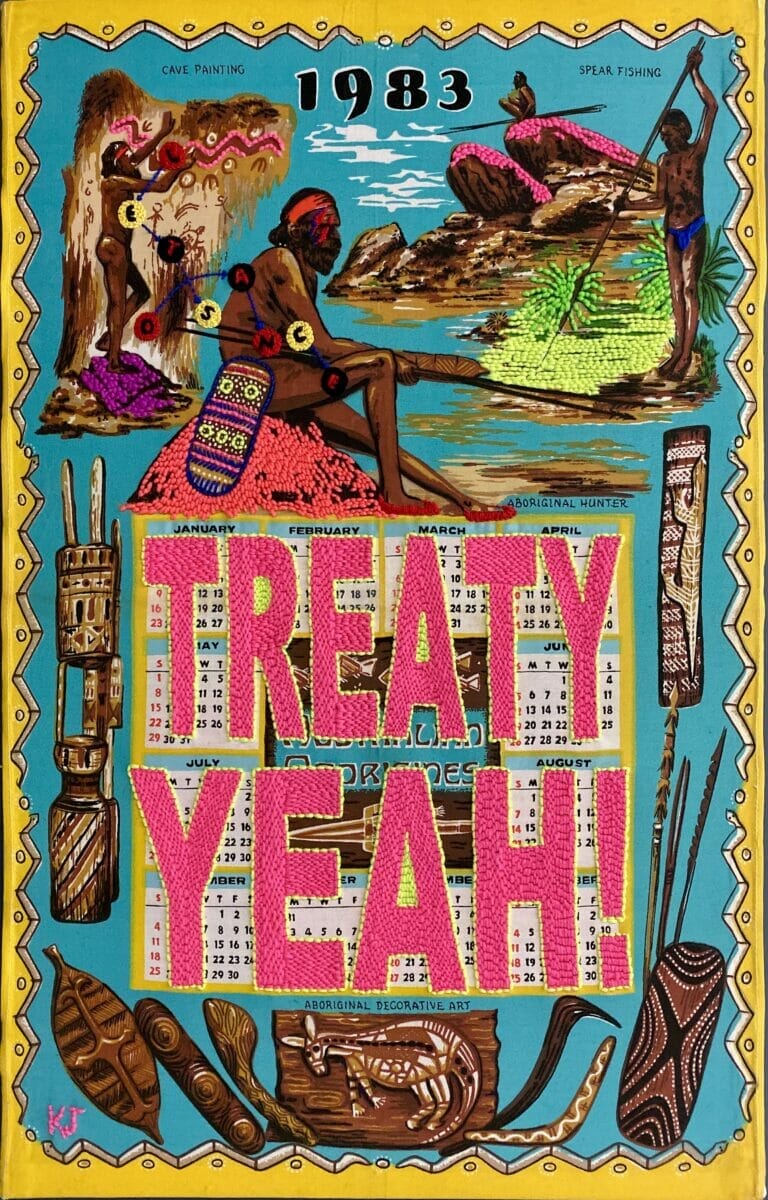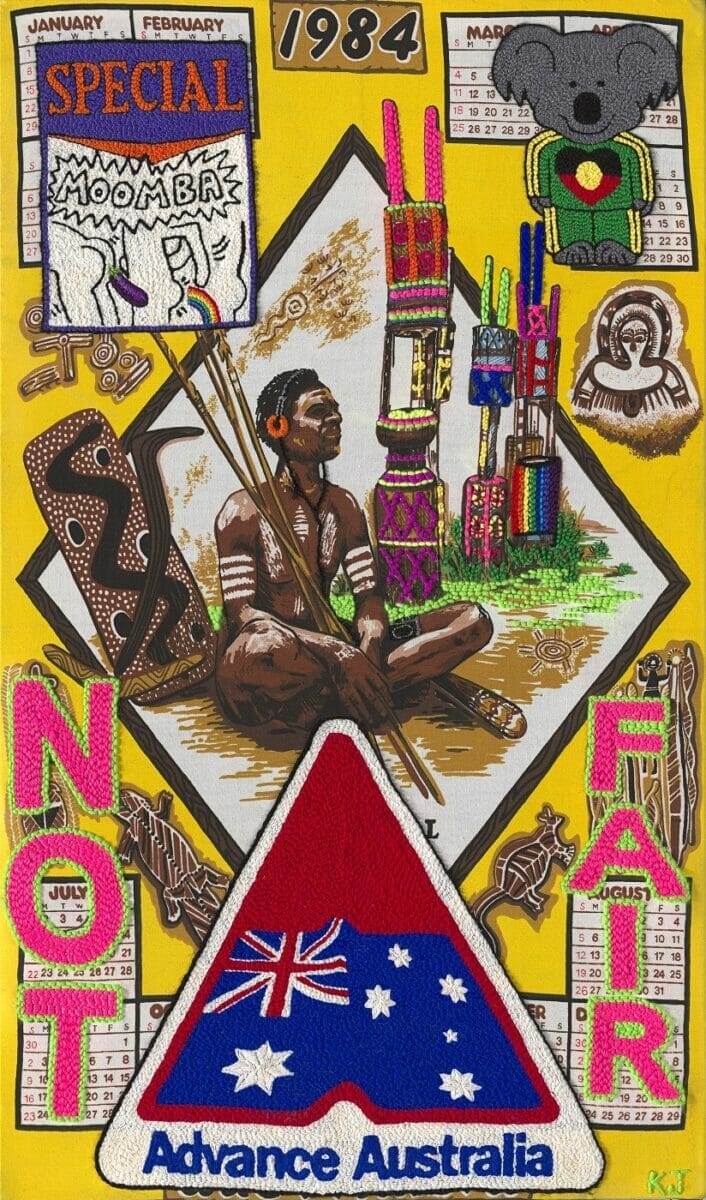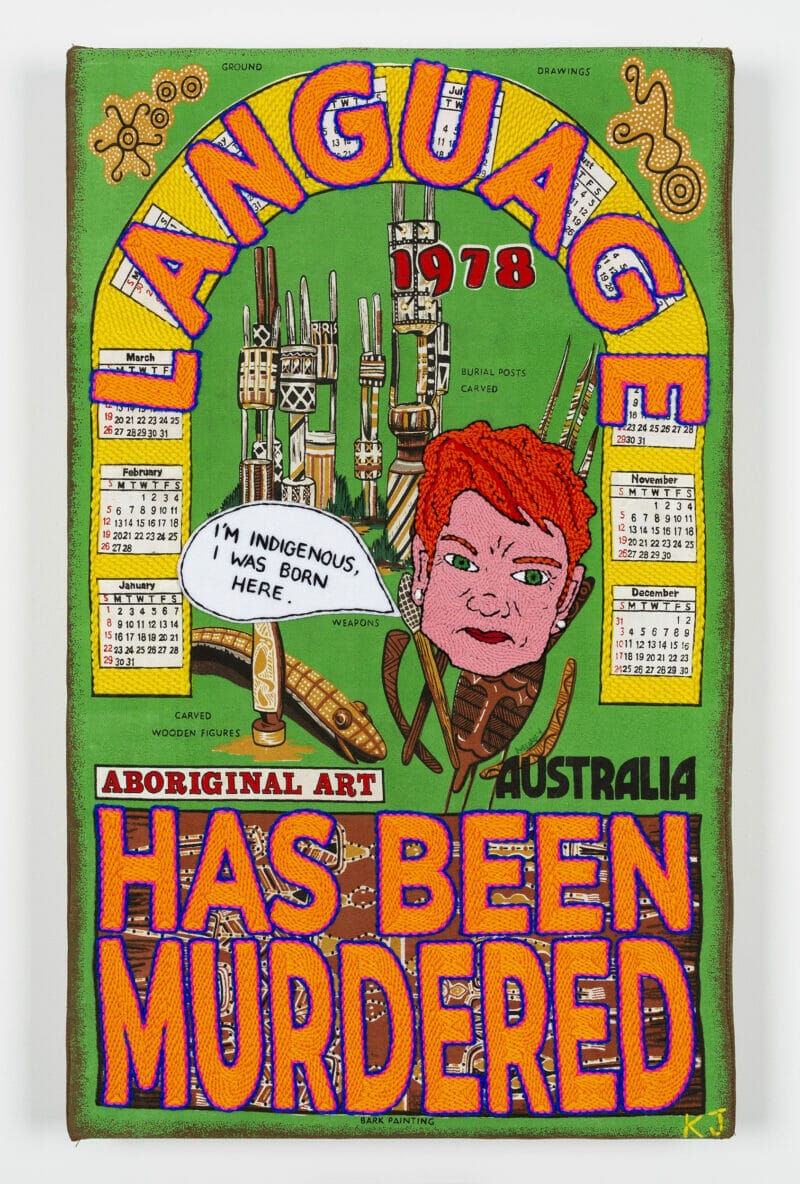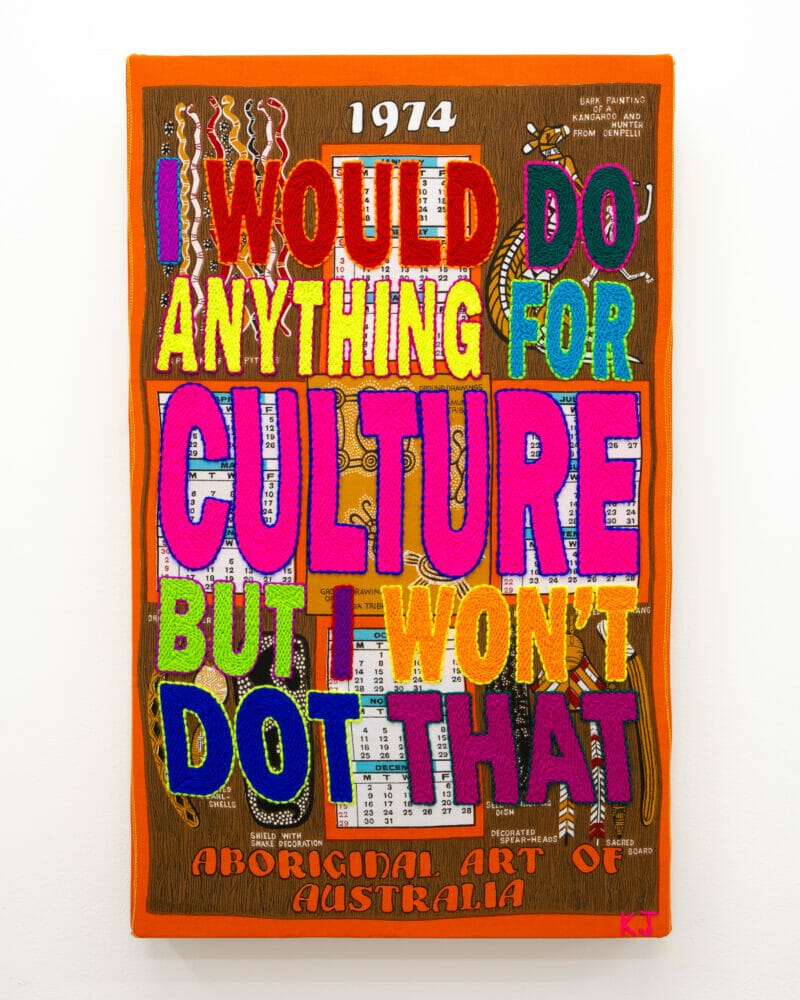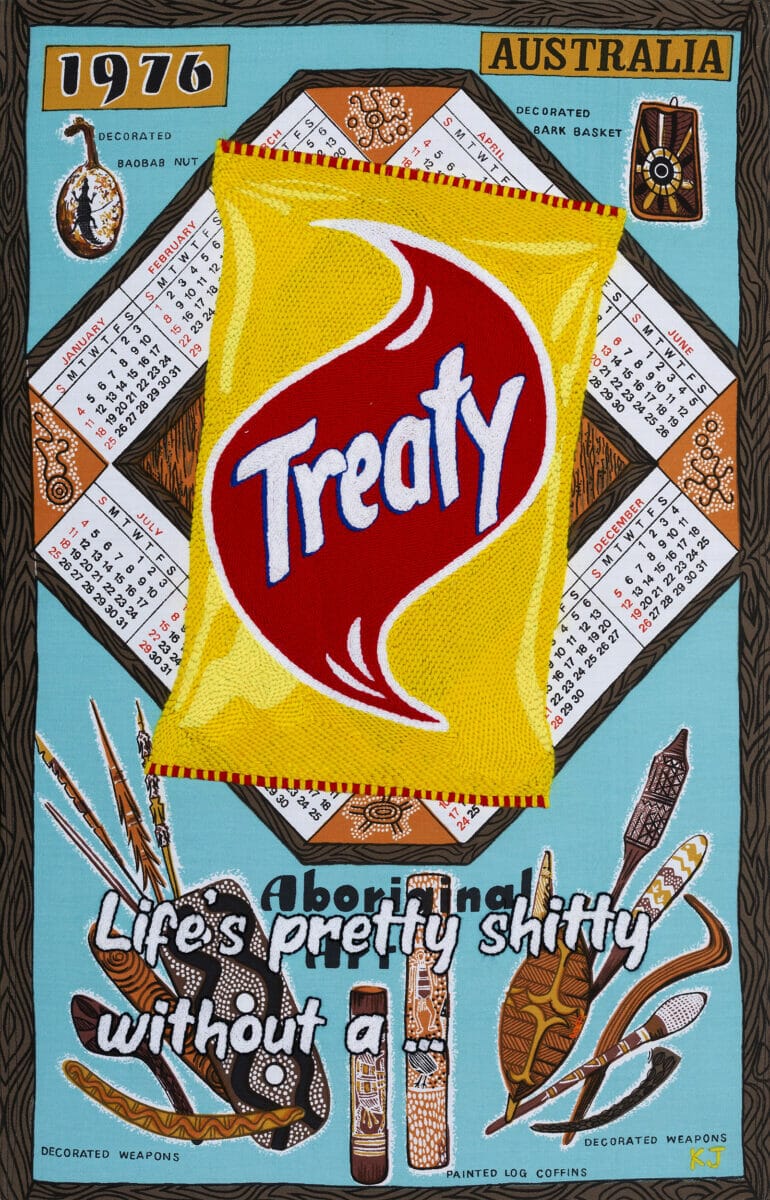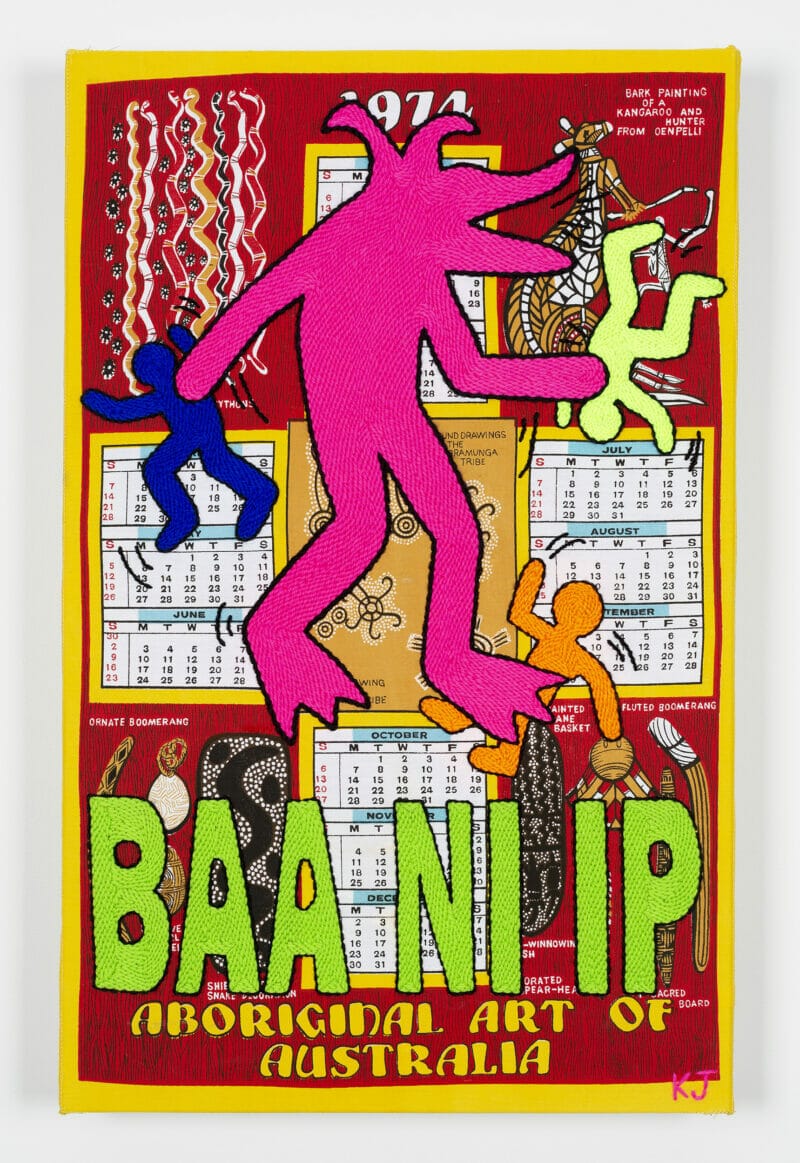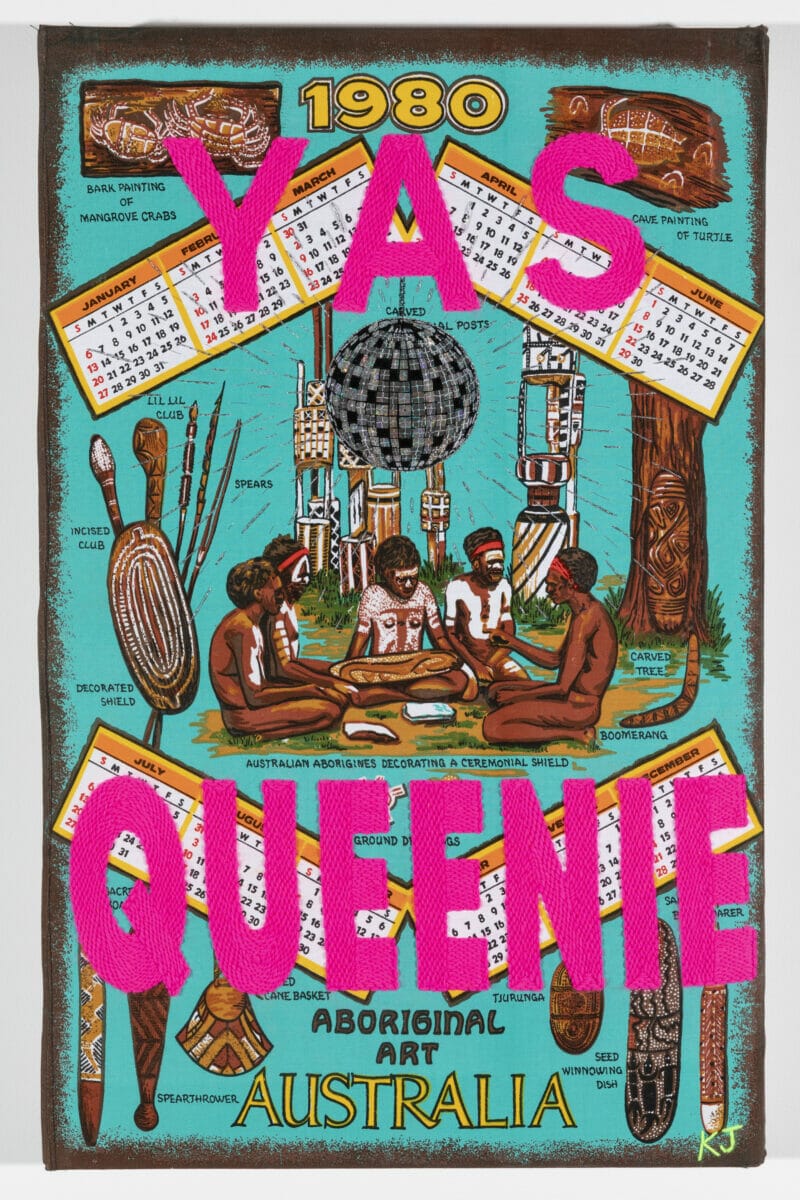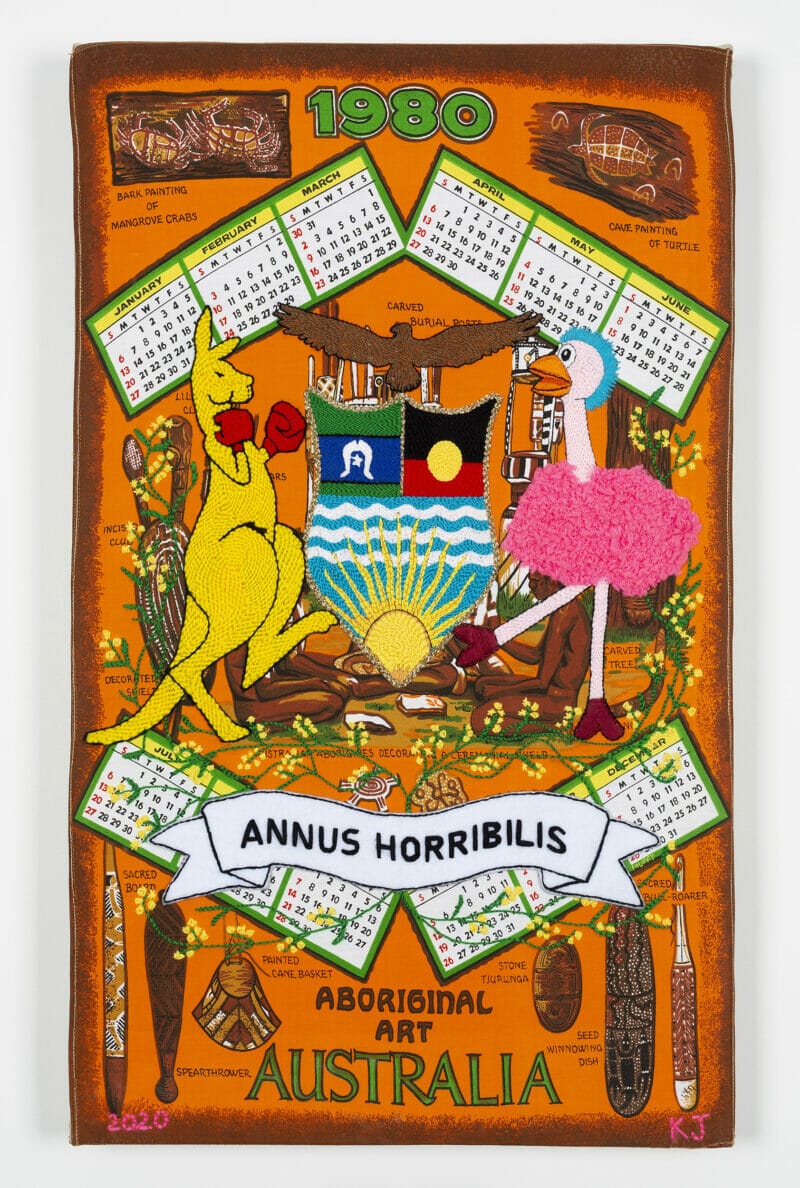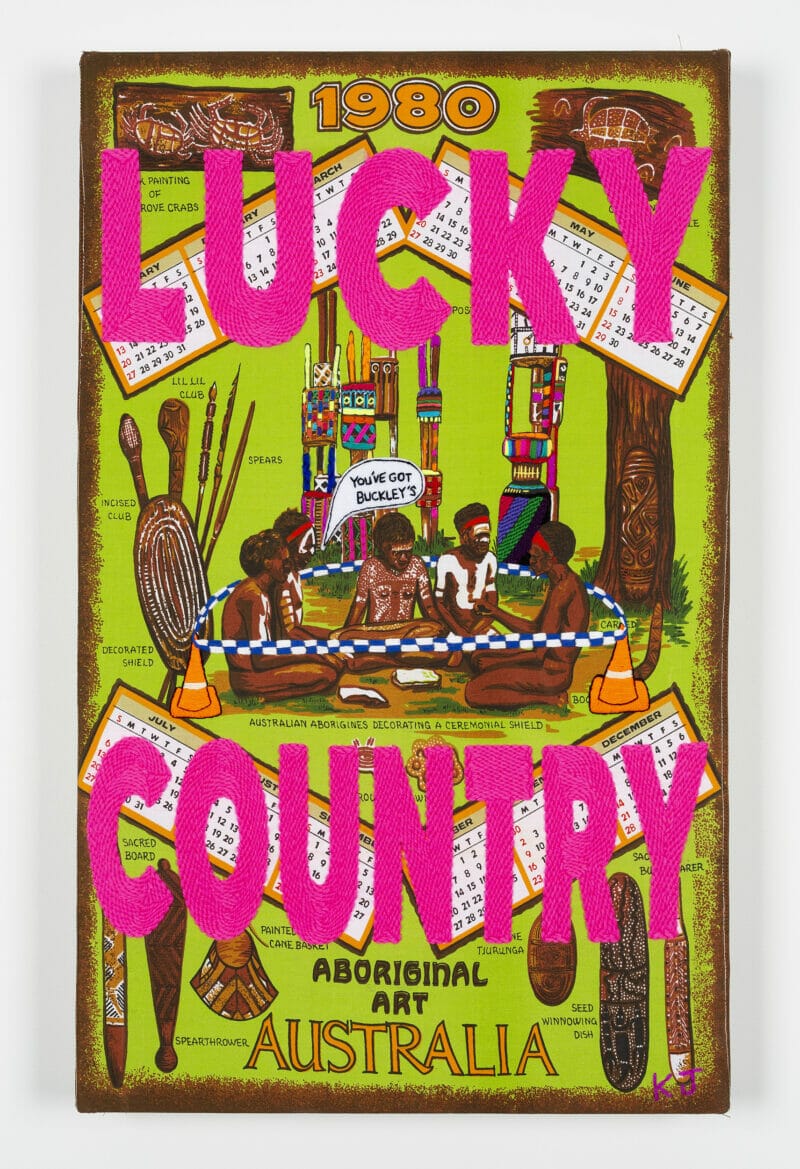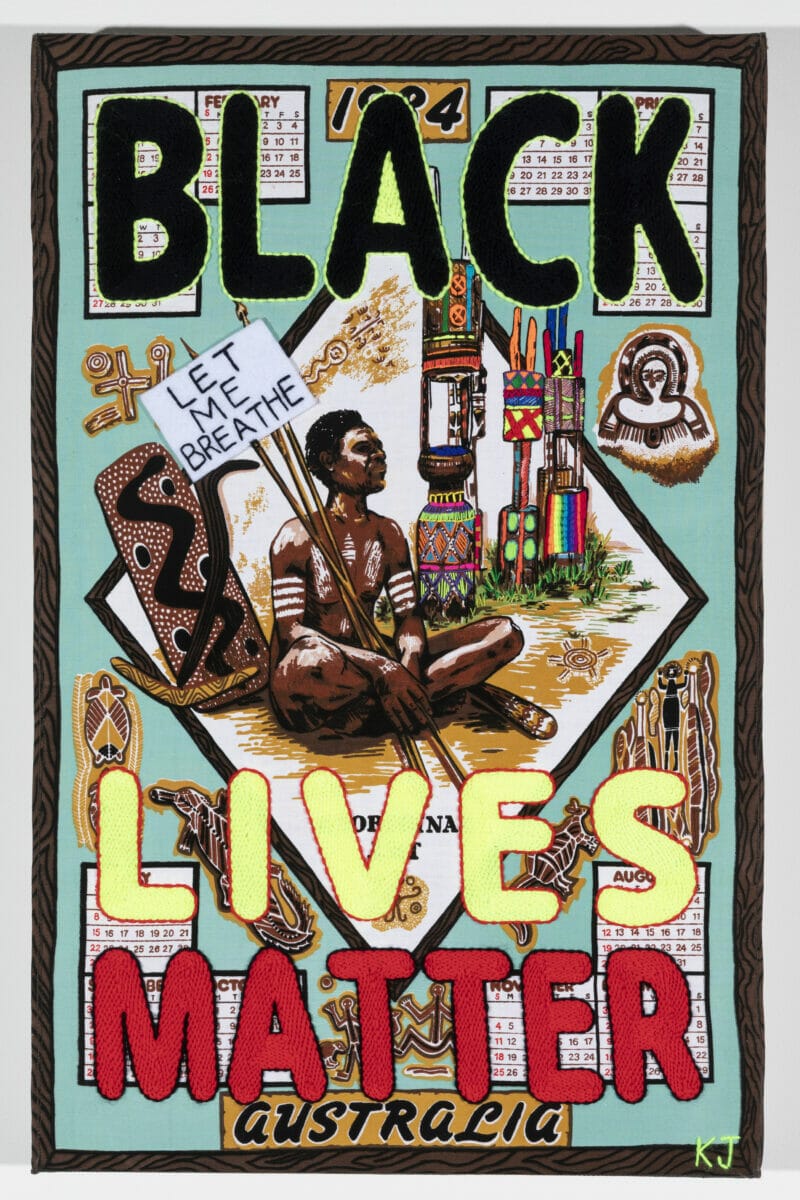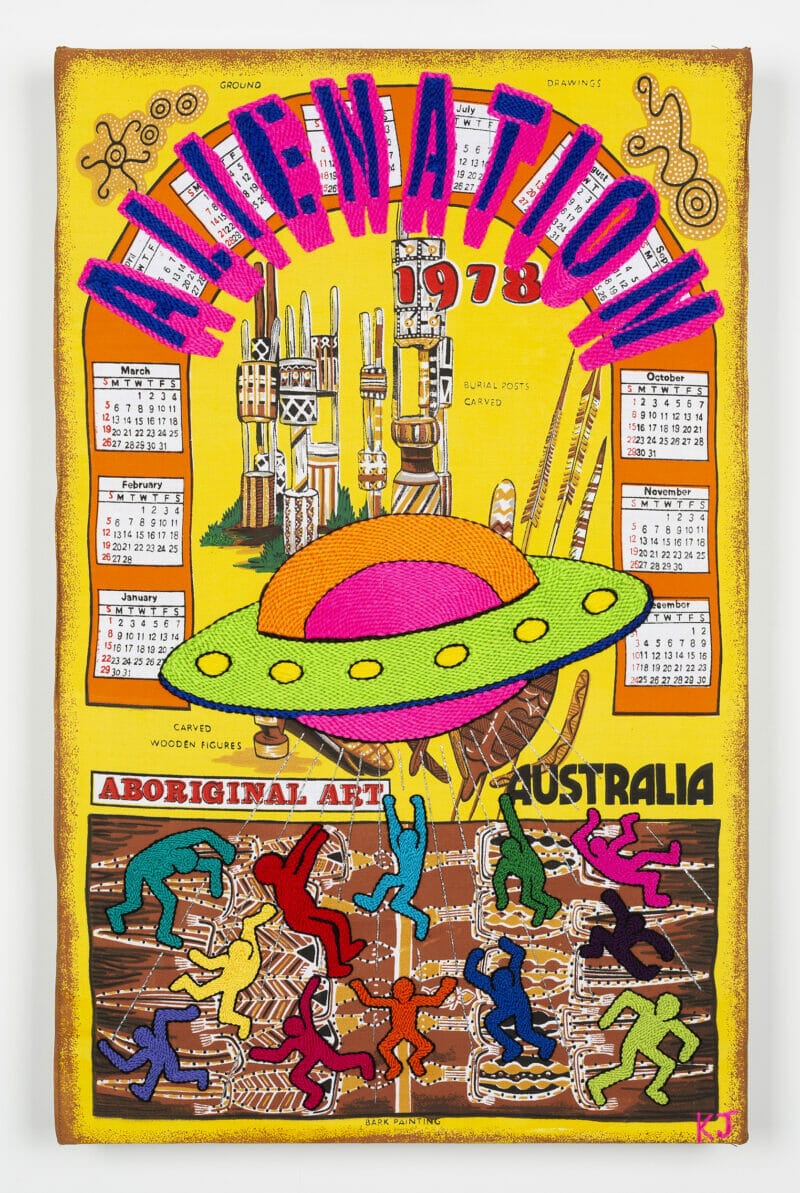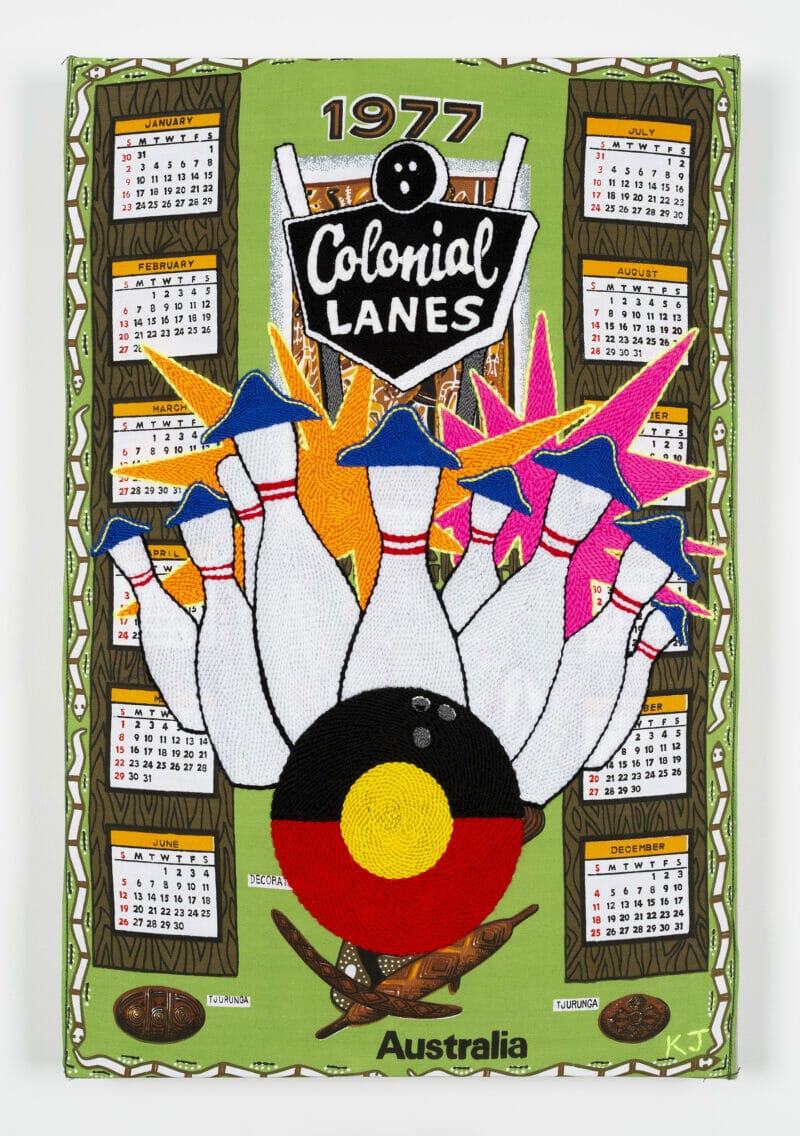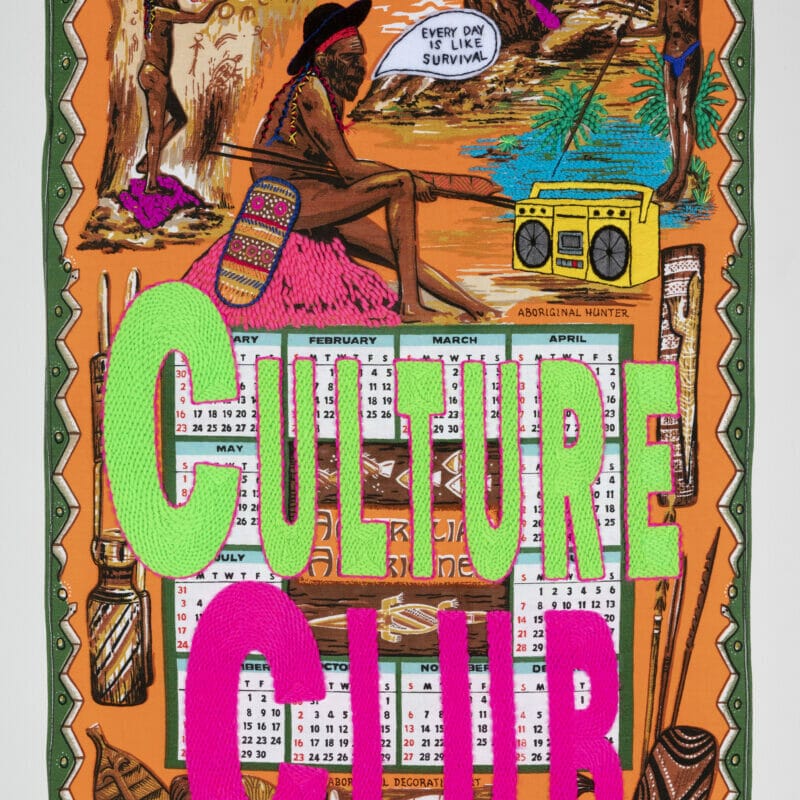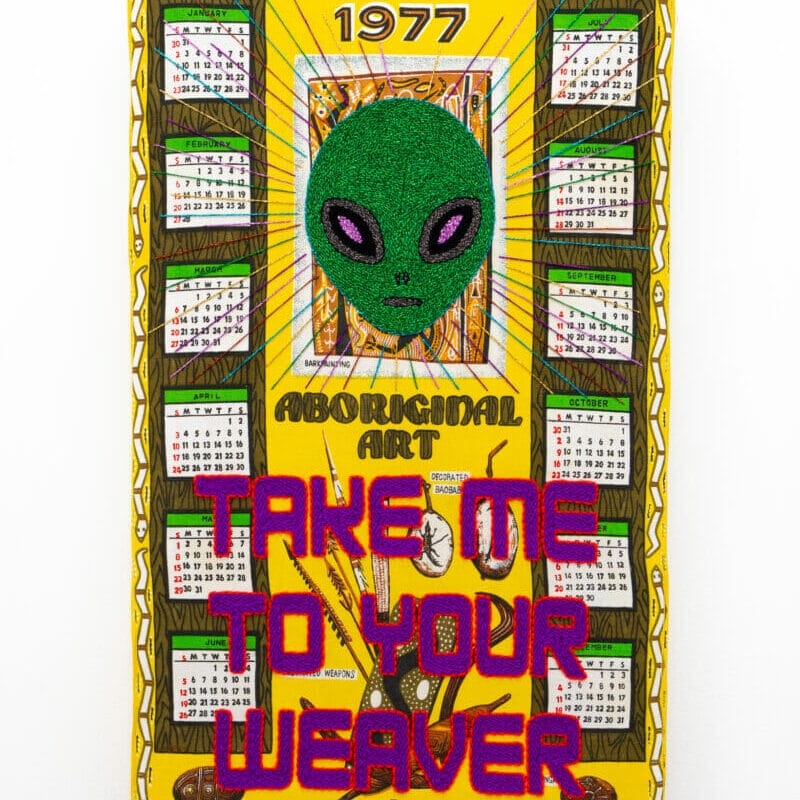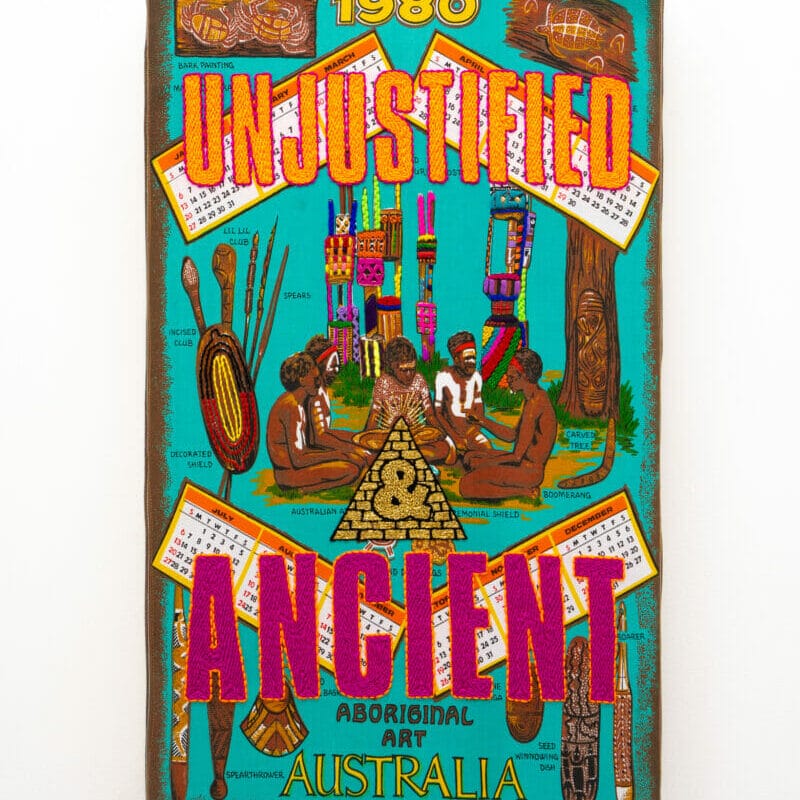KAIT JAMES
*Foto in evidenza: The KLF (Koorie Liberation Front), 2023, Melbourne Now. Ph. credit and copyright Kait James
Kait James is a visual artist currently living and working in Melbourne, Australia. James belongs to the Wadawurrung community, one of Australia’s many indigenous peoples. Indigenous cultural identity is the starting point for a deep reflection that engages the artist in exploring political and social issues related to the protection, respect and sharing of Wadawurrung traditional cultural heritage.
Starting with old salvaged dishcloths, through embroidery, the use of bright colors and images from popular culture, James subverts stereotypical colonial narratives, using art to create awareness and encourage a change of perspective.
Notable accolades to his work include the Craft Victoria Emerging Artist Award for “Stolenwealth Games 2019,” the Lendlease Reconciliation Art Award – Koorie Art Show for ‘Hungry for Land 2019,” and the Churchies Emerging Artist Awards & Exhibition – Institute of Modern Art Brisbane.
There are numerous projects the artist is currently working on that will bring her work to be widely exhibited in the current year.
How did you approach art and what was the path that contributed to your artistic formation?
I’ve always loved making things and spent most of my childhood drawing. I studied a Diploma of Visual Arts and went on to complete a Bachelor of Media Arts/Photography at RMIT University in 2001. This was a transitional period in Photography and I realized Digital Photography was not the medium for me.
I returned to making art in 2018 through my love of culture, one of my beautiful cousins taught me traditional weaving with native grasses, this opportunity gave me confidence to start making art again. I took these skills and started weaving using coloured yarns giving it a contemporary feel.
I was on holiday in Queensland where I purchased some vintage souvenir tea towels and a punch needle at a secondhand shop, as well as some embroidery cotton, and yarn that I hoped to use in my weaving. I wanted to start using the punch needle immediately but didn’t have any material on hand so I used the vintage tea towels. I instinctually added indigenous references and scenes to the tea towels using the yarn.
I tracked down some Aboriginal calendar tea towels online, these were made in the 70s and 80s by non-indigenous people using stolen imagery of shields, spears etc. The imagery is very generalized and stereotypical, something I couldn’t relate to as an Indigenous person growing up in an urban area. I started embroidering them to change the narrative and give them a new life.
I was only making these tea towel works for myself and friends but after receiving positive feedback, I applied and was granted an exhibition at the Koorie Heritage trust in Melbourne. This first solo exhibition titled ‘Dry your dishes on my culture’ was the first major step in becoming a full-time artist.
What is your main source of inspiration and what are the themes that your artistic research focuses on? When and why did your interest in embroidery and the textile medium more generally arise?
I’ve always loved textiles, in particular the use of colour. I’m not professionally trained in textiles but I started watching a lot of embroidery videos online, as well as punch needling and was fascinated with how they used colour, different yarns and fibres to make images. I think it was a natural progression for me using coloured yarn in weaving to embroidery and punch needling that I do today.
My indigenous culture is the main source of inspiration and themes that I use in my work; racism, land rights, Treaty and displacement are just a few of the themes I’ve explored.
There is a general lack of knowledge of indigenous history in Australia, and throughout the world for that matter. To highlight these issues, I use familiar pop culture references from the past as well as present day. I also use a lot of humour in my work, I find that it acts as a shield but also disarms the viewer.
You are a Wadawurrung woman and an artist, two aspects that interpenetrate and nourish each other. How does art allow you to support and help protect the Aboriginal cultural heritage of the Wadawurrung community?
There are over 500 different Indigenous nations in Australia, each with their own language and customs. Wadawurrung Country is located in Victoria, starts at the Werribee River just outside Melbourne, stretches down the coast and includes the large towns of Ballarat and Geelong.
I’m very proud Wadawurrung woman and feel fortunate that I can immerse myself in my culture on a daily basis as well as explore and share it with others. Since colonisation, the previous generations had to hide who they were, we were forbidden to practice culture, to speak language. Fortunately, my cousins and family have worked hard to reclaim our culture, reclaim language and once again be proud of who we are.
I’m very protective of our stories and I don’t use traditional stories in my work very often. I’m a fairly shy person but I use my art as a voice to hopefully educate, create awareness and change perspectives.
I never thought I would be lucky enough to do what I love every day. I do what I do for the future generations, hoping their journey will be an easier ride than the generations before me.
Tell us about the works displayed in the exhibition Hang us out to dry. How did the project for this exhibition come about?
‘Hang us out to dry’ was an exhibition at the Art Gallery of Ballarat in 2021 and featured 22 tea towel works with various themes from colonisation, treaty and the commercialisation of my culture.
This was an amazing opportunity for me, not only because it was held at one of the major galleries in Victoria but also because the gallery is located on Wadawurrung country.
As it was during the pandemic it was rather nerve-racking time, wondering whether the exhibition would actually be open given the number of lockdowns we were having in Melbourne, Victoria. I was very fortunate that the exhibition was open to the public for 4 of the 8 weeks it was due to be open. I know a lot of other artists who also had exhibitions that year that no one got to see or experience.
The exhibition also included my contemporary interpretation of a traditional emu feather skirts which I made from Fluro cord, souvenir teaspoons and emu feathers.
What kind of routine do you have when you start a new project/work? What is a typical day like in your studio?
It really depends on the project I’m working on. Most of the time, an idea will come to me, usually because something that makes me mad or angry. I have a very long list of ideas for future tea towels works! I’ll mock up the work on the computer, I use a lot of text in my work so I love looking at different fonts. Play around with colour combinations and imagery etc.
Up until a few months ago, I made all my work from home. Either in my spare room or just on the couch. Although it was comfortable working from home, it wasn’t good for me as I would start working as soon as I woke up and would work right up until I went to bed. I now have an amazing studio about 10 minutes from home, I love being able to work during the day but come home to relax rather than being surrounded by work 24 hours a day. It is a much better balance and far less stressful.
I often go from one project straight into another so I really need to make an effort to have balance. I try and stay on top of admin and emails in the morning before heading to the studio, there are fewer distractions in the studio, I seem to get a lot more work done and come home at a reasonable time.
Today, social networks provide a possibility of continuous connection with a very large audience. As a emerging artist, how do you live your relationship with the web?
Social media does make it much easier to reach a large audience and be seen by Galleries and Curators. I know established artists my age, who used to visit Galleries to speak to Curators about their work and literally sell themselves in person, I can’t imagine having the time to do this and make work.
I do love following other artists and seeing the amazing work they are doing. Social media doesn’t come naturally to me, I do have to make a special effort to post my work but I am trying to improve and share my work more often.
Are there any contemporary artists that you feel are close to your research and language?
There are so many contemporary artists that I admire, way too many to name. I was recently in an Indigenous exhibition at the National Gallery of Victoria and my work was installed between Destiny Deacon and Kaylene Whiskey; two strong and fierce Indigenous artists who I greatly admire. Never in my wildest dreams did I think my art would end up anywhere near their phenomenal work – it was such an amazing honour and something I will cherish forever.
What are you working on at this time?
I’ve just finished a large commission for NGV’s (National Gallery of Victoria) ‘Melbourne Now’ exhibition which is held every 10 years and features 200 artists from Victoria. This work is called The KLF (Koorie Liberation Front) and is the largest textile work I’ve made, 3 panels 1.4m x 1.6m each and includes fabric collage, embroidery and tufting. Melbourne Now opened last week and will be on show until August 2023.
I’ve just started working on a piece for the Tamworth Textile Triennial which opens in September and will tour Australian galleries for 3 years. Being a part of this Triennial is something I’ve wanted to do since I started working in Textiles, it is very exciting and reaches such a broad audience.
There are quite a few other exhibitions coming up in Sydney, Hobart and Melbourne this year. I’m also working on a few public art projects, most of which I’m unable to talk about at this time.
